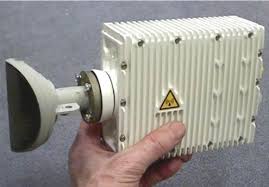Transmit and Receive Integrated Assembly (TRIA)

Instead of an LNB, like you would find on a receive only satellite antenna, an Internet ODU will have what is called a transmit-receive integrated assembly (TRIA). This single device combines to take the place of several, a block-upconverter (BUC), a solid state power amplifier (SSPA), a block-downconverter (LNB), a multiplexer, and a feedhorn.
A transmit and receive integrated assembly (TRIA) is used on a two-way satellite dish to process signals to and from a ground based system and an earth-orbiting satellite.
The TRIA is the part of the antenna which contains both the feed horn and the circuits which convert high-frequency satellite signals such as X-band, Ku-band and Ka-band to and from the L-band microwave signals used for transmission between the dish and the customer-premises equipment. Think of this as the brains of your satellite dish. The “transmit and receive integrated assembly” (TRIA) manages the signals to and from our satellite to the modem in your home.
Explained the components below:
The block upconverter takes the L band signal from the modem and converts it to the carrier frequency,
the SSPA amplifies the signal up to the required transmit power, which can be as high as 1 watt in some of the newer models.
The block downconverter does the same thing as a regular LNB, converts the downlink signal to L band and sends it to the modem.
The multiplexer allows the BUC and LNB to be connected to the same feedhorn, by ensuring that only one is operating at a time.
The feedhorn collects signals from the dish, separates the uplink and downlink frequencies, and selects the correct polarity.
Unlike most TV dishes, the standard Internet antenna has a fixed polarity, to receive RHCP signals you need an RHCP TRIA, likewise with LHCP.